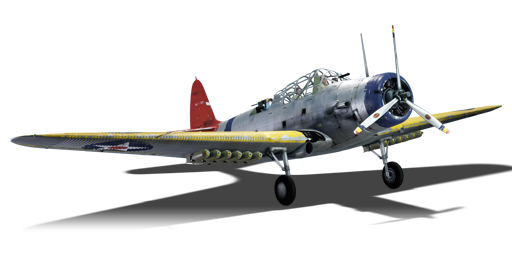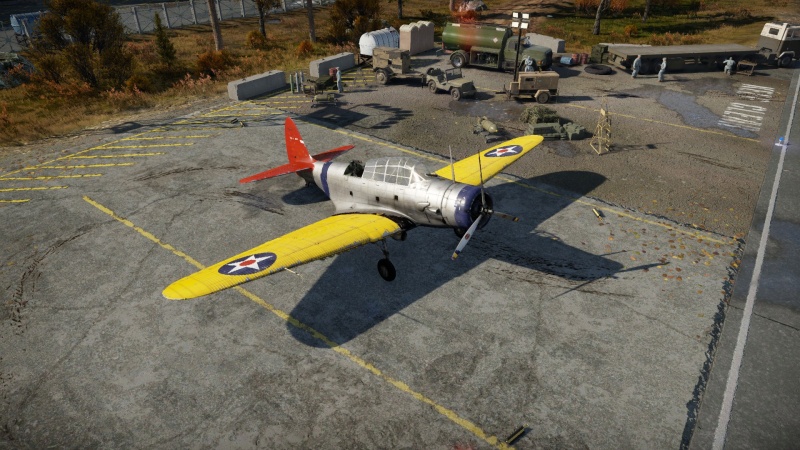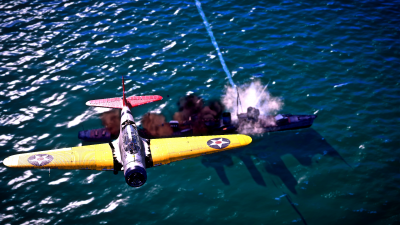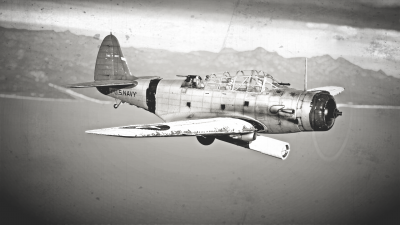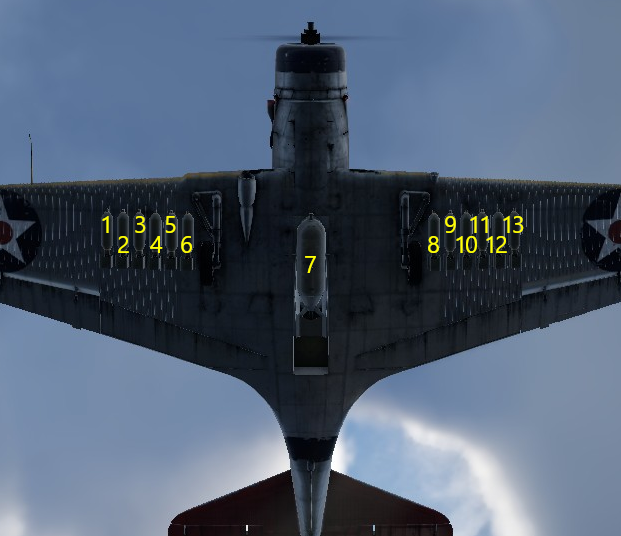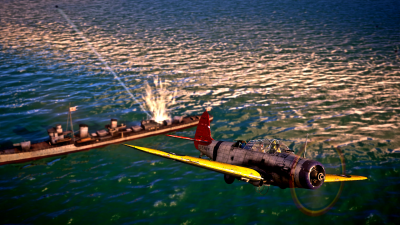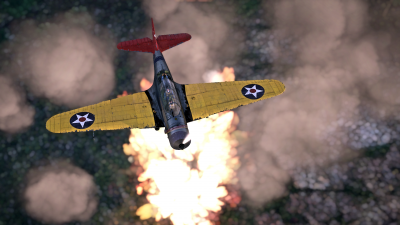Difference between revisions of "TBD-1"
KingDriving (talk | contribs) m (→Pros and cons) (Tag: Visual edit) |
Colok76286 (talk | contribs) (Undo revision 181257 by U165599155 (talk)) |
||
| (16 intermediate revisions by 9 users not shown) | |||
| Line 7: | Line 7: | ||
== Description == | == Description == | ||
<!-- ''In the description, the first part should be about the history of and the creation and combat usage of the aircraft, as well as its key features. In the second part, tell the reader about the aircraft in the game. Insert a screenshot of the vehicle, so that if the novice player does not remember the vehicle by name, he will immediately understand what kind of vehicle the article is talking about.'' --> | <!-- ''In the description, the first part should be about the history of and the creation and combat usage of the aircraft, as well as its key features. In the second part, tell the reader about the aircraft in the game. Insert a screenshot of the vehicle, so that if the novice player does not remember the vehicle by name, he will immediately understand what kind of vehicle the article is talking about.'' --> | ||
| − | The | + | The Devastator had a short lifespan in the US Navy, even though it was, at the time of its introduction, one of the most advanced torpedo bombers. It saw limited use during WWII since it was considered an outdated design, with a very mediocre performance, however this failure can be attributed to the poor reliability of the U.S. Mk. 13 torpedo. A total of 129 units were purchased by the US Navy before WWII, but the Navy decided in 1940 that the Devastator needed to be quickly replaced by the Grumman TBF Avenger, that was much heavier, but also had a much larger payload and was much more survivable. The Devastator was forced into active service, since the Avenger was still not ready, with 41 being deployed for the Battle of Midway and only four returning to the carriers. Most of the losses were attributed to the lack of radios and communication issues. At the end, the Devastator was an example of the technological difference between interwar and WWII developed aircraft. |
| − | The {{PAGENAME}} is the first usable bomber in the U.S. aircraft line-up | + | The {{PAGENAME}} was introduced in [[Update 1.53 "Firestorm"]] and is the first usable bomber in the U.S. aircraft line-up. The Devastator is adept at bombing either naval or land-based targets. On maps with naval ships, torpedoes require the naval bomber to release from a very low altitude, a maximum of 340 ft (104 m) or 820 ft (250 m) depending on the torpedo used. For the pilots who prefer using bombs, they can be just as easily dropped on ships as on land-based vehicles. The aircraft needs to fly quite low to the ground to ensure greater accuracy. The lone offensive machine gun does not offer much but can be effectively used to pick off damaged ground targets or even damage a critical module on an enemy fighter, it is also quite manoeuvrable and can quickly whip around to attempt a second bombing run on a target if there are any bombs left over. |
| − | |||
| − | The lone offensive machine gun does not offer much | ||
== General info == | == General info == | ||
| Line 62: | Line 60: | ||
! Combat !! Take-off !! Landing !! + !! - | ! Combat !! Take-off !! Landing !! + !! - | ||
|- | |- | ||
| − | | {{Specs|destruction|body}} || {{Specs|destruction|gear}} || 212 || 212 || 212 || ~8 || ~2 | + | | 431 <!-- {{Specs|destruction|body}} --> || {{Specs|destruction|gear}} || 212 || 212 || 212 || ~8 || ~2 |
|- | |- | ||
|} | |} | ||
| Line 73: | Line 71: | ||
|- | |- | ||
| < 465 || < 400 || < 380 || > 323 | | < 465 || < 400 || < 380 || > 323 | ||
| − | |||
| − | |||
| − | |||
| − | |||
| − | |||
| − | |||
| − | |||
| − | |||
| − | |||
| − | |||
| − | |||
| − | |||
| − | |||
| − | |||
|- | |- | ||
|} | |} | ||
| Line 106: | Line 90: | ||
{{Specs-Avia-Offensive}} | {{Specs-Avia-Offensive}} | ||
<!-- ''Describe the offensive armament of the aircraft, if any. Describe how effective the cannons and machine guns are in a battle, and also what belts or drums are better to use. If there is no offensive weaponry, delete this subsection.'' --> | <!-- ''Describe the offensive armament of the aircraft, if any. Describe how effective the cannons and machine guns are in a battle, and also what belts or drums are better to use. If there is no offensive weaponry, delete this subsection.'' --> | ||
| − | |||
{{main|M2 Browning (12.7 mm)}} | {{main|M2 Browning (12.7 mm)}} | ||
| Line 116: | Line 99: | ||
{{Specs-Avia-Suspended}} | {{Specs-Avia-Suspended}} | ||
<!-- ''Describe the aircraft's suspended armament: additional cannons under the wings, bombs, rockets and torpedoes. This section is especially important for bombers and attackers. If there is no suspended weaponry remove this subsection.'' --> | <!-- ''Describe the aircraft's suspended armament: additional cannons under the wings, bombs, rockets and torpedoes. This section is especially important for bombers and attackers. If there is no suspended weaponry remove this subsection.'' --> | ||
| − | |||
The '''''{{PAGENAME}}''''' can be outfitted with the following ordnance: | The '''''{{PAGENAME}}''''' can be outfitted with the following ordnance: | ||
| + | |||
| + | {| class="wikitable" style="text-align:center" width="100%" | ||
| + | |- | ||
| + | ! !! width="4%" | 1 !! width="4%" | 2 !! width="4%" | 3 !! width="4%" | 4 !! width="4%" | 5 !! width="4%" | 6 !! width="4%" | 7 !! width="4%" | 8 !! width="4%" | 9 !! width="4%" | 10 !! width="4%" | 11 !! width="4%" | 12 !! width="4%" | 13 | ||
| + | | rowspan="7" width="25%" | <div class="ttx-image">[[File:Hardpoints_{{PAGENAME}}.png]]</div> | ||
| + | |- | ||
| + | ! [[AN-M30A1 (100 lb)|100 lb AN-M30A1]] bombs | ||
| + | | 1 || 1 || 1 || 1 || 1 || 1 || || 1 || 1 || 1 || 1 || 1 || 1 | ||
| + | |- | ||
| + | ! [[AN-M64A1 (500 lb)|500 lb AN-M64A1]] bombs | ||
| + | | || || || || || || 3 || || || || || || | ||
| + | |- | ||
| + | ! [[GP Mk9 (1,000 lb)|1,000 lb GP Mk9]] bombs | ||
| + | | || || || || || || 1 || || || || || || | ||
| + | |- | ||
| + | ! [[Mk.13-6 Case (2,216 lb)|2,216 lb Mk.13-6 Case]] torpedoes | ||
| + | | || || || || || || 1 || || || || || || | ||
| + | |- | ||
| + | ! [[Mk.13-6 (2,216 lb)|2,216 lb Mk.13-6]] torpedoes | ||
| + | | || || || || || || 1 || || || || || || | ||
| + | |- | ||
| + | | colspan="14" | Maximum permissible loadout weight: 1,050 kg | ||
| + | |- | ||
| + | |} | ||
| + | |||
| + | {{Navigation-Start|Default weapon presets}} | ||
| + | {{Navigation-First-Simple-Line}} | ||
* 12 x 100 lb AN-M30A1 bombs (1,200 lb total) | * 12 x 100 lb AN-M30A1 bombs (1,200 lb total) | ||
| − | * 1 x 1, | + | * 3 x 500 lb AN-M64A1 bombs (1,500 lb total) |
| − | * 1 x | + | * 1 x 1,000 lb GP Mk9 bomb (1,000 lb total) |
| − | + | * 1 x 2,216 lb Mk.13-6 torpedo | |
| + | * 1 x 2,216 lb Mk.13-6 Case torpedo | ||
| + | {{Navigation-End}} | ||
=== Defensive armament === | === Defensive armament === | ||
| Line 138: | Line 149: | ||
[[File:TBD-1 an trn 26 002.png|400px|thumb|right|A {{PAGENAME}} scoring a direct torpedo hit on a Japanese ship.]] | [[File:TBD-1 an trn 26 002.png|400px|thumb|right|A {{PAGENAME}} scoring a direct torpedo hit on a Japanese ship.]] | ||
| − | The first thing a pilot will notice about the TBD in gameplay is its "rubber-banding" tendency to return to a stable speed of about 250 km/h. The aircraft has mediocre energy retention, especially in a turn or when coming out of a dive. However, it is a stable and easy plane to fly, even in Realistic Battles. Strangely enough, the TBD has awesome acceleration from a standing start. The acceleration peters off after about 140 km/h (just above its stall speed) but makes it a nice plane to take-off, especially from carriers. The armament on this plane is very bad and will get shot down if engaged with a fighter. The TBD is a very attractive target for fighters so climb to an altitude of | + | The first thing a pilot will notice about the TBD in gameplay is its "rubber-banding" tendency to return to a stable speed of about 250 km/h. The aircraft has mediocre energy retention, especially in a turn or when coming out of a dive. However, it is a stable and easy plane to fly, even in Realistic Battles. Strangely enough, the TBD has awesome acceleration from a standing start. The acceleration peters off after about 140 km/h (just above its stall speed) but makes it a nice plane to take-off, especially from carriers. The armament on this plane is very bad and will get shot down if engaged with a fighter. The TBD is a very attractive target for fighters so climb to an altitude of 5,000 m. When dropping bombs, decrease your throttle to 50% as the bombs are more accurate when flying slow. |
| − | This aircraft is best used in a ground strike role, carpet bombing ground targets with a large quantity of smaller bombs available out of the box, and in this role, it performs respectably. It features a single 12.7 mm MG attached to the starboard side of the engine, with a generous ammo load, but although the TBD has a good turning radius it is not recommended to engage as a fighter. A rear gunner also wields a 7.62 mm MG with a good coverage angle but no coverage under the tail. The 7.62 mm MG is a welcome addition to keep enemies off the TBD's tail but its rate of fire and damage potential are quite mediocre. Aim precisely if you want to hit and spare your ammo. | + | This aircraft is best used in a ground strike role, carpet bombing ground targets with a large quantity of smaller bombs available out of the box, and in this role, it performs respectably. It features a single 12.7 mm MG attached to the starboard side of the engine, with a generous ammo load, but although the TBD has a good turning radius it is not recommended to engage as a fighter. A rear gunner also wields a 7.62 mm MG with a good coverage angle but no coverage under the tail. The 7.62 mm MG is a welcome addition to keep enemies off the TBD's tail but its rate of fire and damage potential are quite mediocre. Aim precisely if you want to hit and spare your ammo. Of special mention is the pilot's telescopic sight, which is at best a novelty in air battles but is immensely useful in realistic tank battles, where one can easily scan and nitpick otherwise hard to discern enemy tanks. Be careful not to get too stuck in tunnel vision and forget to pull up or evade enemy fire. |
It is important to note that the TBD suffers from extremely fragile flaps and gear, at least in Realistic and Simulator Battles; even combat flaps will break off at any speed above about 210 km/h, while the gear rips at about 180. | It is important to note that the TBD suffers from extremely fragile flaps and gear, at least in Realistic and Simulator Battles; even combat flaps will break off at any speed above about 210 km/h, while the gear rips at about 180. | ||
| Line 163: | Line 174: | ||
=== Pros and cons === | === Pros and cons === | ||
<!-- ''Summarise and briefly evaluate the vehicle in terms of its characteristics and combat effectiveness. Mark its pros and cons in the bulleted list. Try not to use more than 6 points for each of the characteristics. Avoid using categorical definitions such as "bad", "good" and the like - use substitutions with softer forms such as "inadequate" and "effective".'' --> | <!-- ''Summarise and briefly evaluate the vehicle in terms of its characteristics and combat effectiveness. Mark its pros and cons in the bulleted list. Try not to use more than 6 points for each of the characteristics. Avoid using categorical definitions such as "bad", "good" and the like - use substitutions with softer forms such as "inadequate" and "effective".'' --> | ||
| + | [[File:TBD-1 an trn 26 004.png|400px|thumb|right|A {{PAGENAME}} blitzing ground artillery with a mix of 100 and 500 lb bombs.]] | ||
'''Pros:''' | '''Pros:''' | ||
| Line 170: | Line 182: | ||
* Has an arrestor hook for carrier landing | * Has an arrestor hook for carrier landing | ||
* Very stable and easy to fly | * Very stable and easy to fly | ||
| − | * Very | + | * Very manoeuvrable for a bomber: very good turn and roll rate |
* Carries a decent quantity of bombs without requiring any research | * Carries a decent quantity of bombs without requiring any research | ||
* Great standing acceleration | * Great standing acceleration | ||
* Cockpit offers decent visibility | * Cockpit offers decent visibility | ||
* Excellent low-speed handling and low stall speed, great aircraft for pilots to learn how to use torpedoes | * Excellent low-speed handling and low stall speed, great aircraft for pilots to learn how to use torpedoes | ||
| − | |||
'''Cons:''' | '''Cons:''' | ||
| − | * Prone to wing snapping when pulling 3 | + | * Prone to wing snapping when pulling 3 G flying at mid to high speeds |
* Poor overall armament with limited defensive coverage, with a single 12.7 mm in front and a 7.62 mm in the rear | * Poor overall armament with limited defensive coverage, with a single 12.7 mm in front and a 7.62 mm in the rear | ||
* Low sustainable "cruise" speed (200-250 km/h) | * Low sustainable "cruise" speed (200-250 km/h) | ||
* Very bad energy retention | * Very bad energy retention | ||
* Bombs are mounted on external pylons | * Bombs are mounted on external pylons | ||
| − | * A dive bomber without any air brakes | + | * A dive bomber with a rather low wing rip speed and without any air brakes |
* No gun sight in cockpit other than a scope with an extremely limited (and very shaky) field of view | * No gun sight in cockpit other than a scope with an extremely limited (and very shaky) field of view | ||
* Does not come with its Navy Blue camouflage unlike other US Navy planes | * Does not come with its Navy Blue camouflage unlike other US Navy planes | ||
* Fragile flaps and landing gear | * Fragile flaps and landing gear | ||
| − | * Gunner has no | + | * Gunner has no armour protection |
| − | |||
| − | |||
| − | |||
== History == | == History == | ||
| Line 200: | Line 208: | ||
The Devastator had a strong start as a winner of a U.S. Navy competition for a new carrier-based bomber. This aircraft included many firsts for the Navy as the {{PAGENAME}} was a monoplane manufactured from all metal (no fabric covering for any surfaces), and hydraulically folding wings to allowing stowage of more aircraft on the carrier. The Devastator had a crew of three, the pilot would fly the aircraft and operate the single forward-facing machine gun while the bombardier who sat in the centre of the cockpit would lay prone on the bottom of the aircraft and would aim the Norden bombsight located under the pilot's seat through a window in the belly of the aircraft. The third crew member was the radio operator/rear gunner who also operated a single machine gun in the dorsal turret to fend off any attacking enemy aircraft. | The Devastator had a strong start as a winner of a U.S. Navy competition for a new carrier-based bomber. This aircraft included many firsts for the Navy as the {{PAGENAME}} was a monoplane manufactured from all metal (no fabric covering for any surfaces), and hydraulically folding wings to allowing stowage of more aircraft on the carrier. The Devastator had a crew of three, the pilot would fly the aircraft and operate the single forward-facing machine gun while the bombardier who sat in the centre of the cockpit would lay prone on the bottom of the aircraft and would aim the Norden bombsight located under the pilot's seat through a window in the belly of the aircraft. The third crew member was the radio operator/rear gunner who also operated a single machine gun in the dorsal turret to fend off any attacking enemy aircraft. | ||
| − | A total of 129 {{PAGENAME}} units were purchased and delivered to the U.S. Navy and were farmed out to several aircraft carriers such as the notable Enterprise, Lexington, Wasp and Hornet. Unfortunately, the Navy realized by 1940 that the Devastator was not the frontline bomber it needed and its replacement the Grumman TBF Avenger was not yet at a stage where it could be operational. Though outclassed by many Japanese fighters, the {{PAGENAME}} was still pressed into active service, however, as an example, 41 were deployed during the Battle of Midway with only four returning to the carriers. Though other factors contributed such as miscommunication and uncoordinated sorties, the Devastators flew without fighter cover and were easily picked off when lining up for torpedo runs often flying in a straight line at around | + | A total of 129 {{PAGENAME}} units were purchased and delivered to the U.S. Navy and were farmed out to several aircraft carriers such as the notable Enterprise, Lexington, Wasp and Hornet. Unfortunately, the Navy realized by 1940 that the Devastator was not the frontline bomber it needed and its replacement the Grumman TBF Avenger was not yet at a stage where it could be operational. Though outclassed by many Japanese fighters, the {{PAGENAME}} was still pressed into active service, however, as an example, 41 were deployed during the Battle of Midway with only four returning to the carriers. Though other factors contributed such as miscommunication and uncoordinated sorties, the Devastators flew without fighter cover and were easily picked off when lining up for torpedo runs often flying in a straight line at around 185 km/h (115 mph). Ship batteries also had an easy time bearing down on these slow and predictable torpedo runs. Though, the attacks were not a complete waste, as the Devastator attacks tied up the Imperial Japanese Navy and their protective fighters which allowed the late-arriving SBD dauntless dive bombers to inflict massive damage on the IJN carriers with very little resistance allowing them to carry out more effective attacks. |
The Battle of Midway showed the technological age of the Devastator and the Navy elected to withdraw the remaining {{PAGENAME}}s from active service and relegate them to training duty for both pilots and mechanics, while others were used by firefighters to practice extinguishing aircraft fires. All surviving Devastators are unsalvageable wrecks (the U.S. Navy will not relinquish ownership and thus cannot be salvaged) with one sitting in the Atlantic Ocean off of Miami, Florida USA, another in the Pacific Ocean just off of the coast of Mission Beach, California USA, two more in Jaluit Lagoon in the Marshall Islands and seven resting near the USS Lexington on the ocean floor of the Coral Sea. | The Battle of Midway showed the technological age of the Devastator and the Navy elected to withdraw the remaining {{PAGENAME}}s from active service and relegate them to training duty for both pilots and mechanics, while others were used by firefighters to practice extinguishing aircraft fires. All surviving Devastators are unsalvageable wrecks (the U.S. Navy will not relinquish ownership and thus cannot be salvaged) with one sitting in the Atlantic Ocean off of Miami, Florida USA, another in the Pacific Ocean just off of the coast of Mission Beach, California USA, two more in Jaluit Lagoon in the Marshall Islands and seven resting near the USS Lexington on the ocean floor of the Coral Sea. | ||
| Line 209: | Line 217: | ||
;Skins | ;Skins | ||
| − | * [https://live.warthunder.com/feed/camouflages/? | + | * [https://live.warthunder.com/feed/camouflages/?vehicle=tbd-1_1938 Skins and camouflages for the {{PAGENAME}} from live.warthunder.com.] |
;Videos | ;Videos | ||
Latest revision as of 08:00, 4 February 2024
Contents
Description
The Devastator had a short lifespan in the US Navy, even though it was, at the time of its introduction, one of the most advanced torpedo bombers. It saw limited use during WWII since it was considered an outdated design, with a very mediocre performance, however this failure can be attributed to the poor reliability of the U.S. Mk. 13 torpedo. A total of 129 units were purchased by the US Navy before WWII, but the Navy decided in 1940 that the Devastator needed to be quickly replaced by the Grumman TBF Avenger, that was much heavier, but also had a much larger payload and was much more survivable. The Devastator was forced into active service, since the Avenger was still not ready, with 41 being deployed for the Battle of Midway and only four returning to the carriers. Most of the losses were attributed to the lack of radios and communication issues. At the end, the Devastator was an example of the technological difference between interwar and WWII developed aircraft.
The TBD-1 was introduced in Update 1.53 "Firestorm" and is the first usable bomber in the U.S. aircraft line-up. The Devastator is adept at bombing either naval or land-based targets. On maps with naval ships, torpedoes require the naval bomber to release from a very low altitude, a maximum of 340 ft (104 m) or 820 ft (250 m) depending on the torpedo used. For the pilots who prefer using bombs, they can be just as easily dropped on ships as on land-based vehicles. The aircraft needs to fly quite low to the ground to ensure greater accuracy. The lone offensive machine gun does not offer much but can be effectively used to pick off damaged ground targets or even damage a critical module on an enemy fighter, it is also quite manoeuvrable and can quickly whip around to attempt a second bombing run on a target if there are any bombs left over.
General info
Flight performance
The TBD-1 Devastator is a very slow but useful aircraft. It has a max speed of 327 km/h in Arcade Battles and 312 km/h in Realistic battles. The TBD-1 devastator has a pretty decent turn time for a bomber, making it viable for the most extreme of the pilots to use it as a basic dogfighter. Its slow speed makes the aircraft vulnerable to enemy fighter attacks, so be sure to bring a fighter escort!
| Characteristics | Max Speed (km/h at 2,500 m) |
Max altitude (metres) |
Turn time (seconds) |
Rate of climb (metres/second) |
Take-off run (metres) | |||
|---|---|---|---|---|---|---|---|---|
| AB | RB | AB | RB | AB | RB | |||
| Stock | 298 | 287 | 6000 | 19.8 | 20.5 | 4.3 | 4.3 | 150 |
| Upgraded | 327 | 312 | 18.3 | 19.0 | 8.3 | 6.1 | ||
Details
| Features | ||||
|---|---|---|---|---|
| Combat flaps | Take-off flaps | Landing flaps | Air brakes | Arrestor gear |
| ✓ | ✓ | ✓ | X | ✓ |
| Limits | ||||||
|---|---|---|---|---|---|---|
| Wings (km/h) | Gear (km/h) | Flaps (km/h) | Max Static G | |||
| Combat | Take-off | Landing | + | - | ||
| 431 | 185 | 212 | 212 | 212 | ~8 | ~2 |
| Optimal velocities (km/h) | |||
|---|---|---|---|
| Ailerons | Rudder | Elevators | Radiator |
| < 465 | < 400 | < 380 | > 323 |
Survivability and armour
- 12.7 mm steel - behind the engine
- 12.7 mm steel - behind pilot's head
- Self-sealing fuel tanks (1 in each wing)
Modifications and economy
Armaments
Offensive armament
The TBD-1 is armed with:
- 1 x 12.7 mm M2 Browning machine gun, nose-mounted (500 rpg)
Suspended armament
The TBD-1 can be outfitted with the following ordnance:
| 1 | 2 | 3 | 4 | 5 | 6 | 7 | 8 | 9 | 10 | 11 | 12 | 13 | ||
|---|---|---|---|---|---|---|---|---|---|---|---|---|---|---|
| 100 lb AN-M30A1 bombs | 1 | 1 | 1 | 1 | 1 | 1 | 1 | 1 | 1 | 1 | 1 | 1 | ||
| 500 lb AN-M64A1 bombs | 3 | |||||||||||||
| 1,000 lb GP Mk9 bombs | 1 | |||||||||||||
| 2,216 lb Mk.13-6 Case torpedoes | 1 | |||||||||||||
| 2,216 lb Mk.13-6 torpedoes | 1 | |||||||||||||
| Maximum permissible loadout weight: 1,050 kg | ||||||||||||||
| Default weapon presets | |
|---|---|
| |
Defensive armament
The TBD-1 is defended by:
- 1 x 7.62 mm Browning machine gun, dorsal turret (600 rpg)
Usage in battles
The first thing a pilot will notice about the TBD in gameplay is its "rubber-banding" tendency to return to a stable speed of about 250 km/h. The aircraft has mediocre energy retention, especially in a turn or when coming out of a dive. However, it is a stable and easy plane to fly, even in Realistic Battles. Strangely enough, the TBD has awesome acceleration from a standing start. The acceleration peters off after about 140 km/h (just above its stall speed) but makes it a nice plane to take-off, especially from carriers. The armament on this plane is very bad and will get shot down if engaged with a fighter. The TBD is a very attractive target for fighters so climb to an altitude of 5,000 m. When dropping bombs, decrease your throttle to 50% as the bombs are more accurate when flying slow.
This aircraft is best used in a ground strike role, carpet bombing ground targets with a large quantity of smaller bombs available out of the box, and in this role, it performs respectably. It features a single 12.7 mm MG attached to the starboard side of the engine, with a generous ammo load, but although the TBD has a good turning radius it is not recommended to engage as a fighter. A rear gunner also wields a 7.62 mm MG with a good coverage angle but no coverage under the tail. The 7.62 mm MG is a welcome addition to keep enemies off the TBD's tail but its rate of fire and damage potential are quite mediocre. Aim precisely if you want to hit and spare your ammo. Of special mention is the pilot's telescopic sight, which is at best a novelty in air battles but is immensely useful in realistic tank battles, where one can easily scan and nitpick otherwise hard to discern enemy tanks. Be careful not to get too stuck in tunnel vision and forget to pull up or evade enemy fire.
It is important to note that the TBD suffers from extremely fragile flaps and gear, at least in Realistic and Simulator Battles; even combat flaps will break off at any speed above about 210 km/h, while the gear rips at about 180.
Manual Engine Control
| MEC elements | ||||||
|---|---|---|---|---|---|---|
| Mixer | Pitch | Radiator | Supercharger | Turbocharger | ||
| Oil | Water | Type | ||||
| Controllable | Controllable Not auto controlled |
Not controllable Not auto controlled |
Controllable Auto control available |
Separate | Not controllable 1 gear |
Not controllable |
Pros and cons
Pros:
- Easily capable of flying back to base with one wing
- Has a bomb sight
- Has an arrestor hook for carrier landing
- Very stable and easy to fly
- Very manoeuvrable for a bomber: very good turn and roll rate
- Carries a decent quantity of bombs without requiring any research
- Great standing acceleration
- Cockpit offers decent visibility
- Excellent low-speed handling and low stall speed, great aircraft for pilots to learn how to use torpedoes
Cons:
- Prone to wing snapping when pulling 3 G flying at mid to high speeds
- Poor overall armament with limited defensive coverage, with a single 12.7 mm in front and a 7.62 mm in the rear
- Low sustainable "cruise" speed (200-250 km/h)
- Very bad energy retention
- Bombs are mounted on external pylons
- A dive bomber with a rather low wing rip speed and without any air brakes
- No gun sight in cockpit other than a scope with an extremely limited (and very shaky) field of view
- Does not come with its Navy Blue camouflage unlike other US Navy planes
- Fragile flaps and landing gear
- Gunner has no armour protection
History
The active-duty life of the TBD-1 Devastator was a relatively short one in which it went from being the Navy's most advanced aircraft in service to being outdated only three years later and then removed from active service within five years. Though seeing limited action during WWII and recorded performance as abysmal later was vindicated when documentation recorded that the U.S. Mk. 13 torpedo, one of the main suspended armaments of this aircraft was to share much of this blame as their failure rate (sinking, not-exploding, running cold, not running true, porposing) was extremely high.
The Devastator had a strong start as a winner of a U.S. Navy competition for a new carrier-based bomber. This aircraft included many firsts for the Navy as the TBD-1 was a monoplane manufactured from all metal (no fabric covering for any surfaces), and hydraulically folding wings to allowing stowage of more aircraft on the carrier. The Devastator had a crew of three, the pilot would fly the aircraft and operate the single forward-facing machine gun while the bombardier who sat in the centre of the cockpit would lay prone on the bottom of the aircraft and would aim the Norden bombsight located under the pilot's seat through a window in the belly of the aircraft. The third crew member was the radio operator/rear gunner who also operated a single machine gun in the dorsal turret to fend off any attacking enemy aircraft.
A total of 129 TBD-1 units were purchased and delivered to the U.S. Navy and were farmed out to several aircraft carriers such as the notable Enterprise, Lexington, Wasp and Hornet. Unfortunately, the Navy realized by 1940 that the Devastator was not the frontline bomber it needed and its replacement the Grumman TBF Avenger was not yet at a stage where it could be operational. Though outclassed by many Japanese fighters, the TBD-1 was still pressed into active service, however, as an example, 41 were deployed during the Battle of Midway with only four returning to the carriers. Though other factors contributed such as miscommunication and uncoordinated sorties, the Devastators flew without fighter cover and were easily picked off when lining up for torpedo runs often flying in a straight line at around 185 km/h (115 mph). Ship batteries also had an easy time bearing down on these slow and predictable torpedo runs. Though, the attacks were not a complete waste, as the Devastator attacks tied up the Imperial Japanese Navy and their protective fighters which allowed the late-arriving SBD dauntless dive bombers to inflict massive damage on the IJN carriers with very little resistance allowing them to carry out more effective attacks.
The Battle of Midway showed the technological age of the Devastator and the Navy elected to withdraw the remaining TBD-1s from active service and relegate them to training duty for both pilots and mechanics, while others were used by firefighters to practice extinguishing aircraft fires. All surviving Devastators are unsalvageable wrecks (the U.S. Navy will not relinquish ownership and thus cannot be salvaged) with one sitting in the Atlantic Ocean off of Miami, Florida USA, another in the Pacific Ocean just off of the coast of Mission Beach, California USA, two more in Jaluit Lagoon in the Marshall Islands and seven resting near the USS Lexington on the ocean floor of the Coral Sea.
Media
- Skins
- Videos
See also
Links to the articles on the War Thunder Wiki that you think will be useful for the reader, for example:
- reference to the series of the aircraft;
- links to approximate analogues of other nations and research trees.
External links
| Douglas Aircraft Company | |
|---|---|
| Strike Aircraft | A-20G-25 · A-26B-10 · A-26B-50 · AD-2 · AD-4 · A-1H |
| Bombers | TBD-1 · B-18A · SBD-3 · BTD-1 · A-26C-45 · A-26C-45DT |
| Turboprops | A2D-1 |
| Jet Aircraft | F3D-1 · F4D-1 |
| A-4 Skyhawk | A-4B · A-4E Early |
| Export | ▄Havoc Mk I · ▄Boston Mk I · ▄DB-7 · ▂A-20G-30 · ▄AD-4 · ▄AD-4NA |
| A-4 Skyhawk | A-4H · A-4E Early (M) · Ayit · A-4E |
| The Douglas Aircraft Company merged with McDonnell Aircraft Corporation in 1967 to form McDonnell Douglas. | |
| USA bombers | |
|---|---|
| Dive | SB2U-2 · SB2U-3 · SBD-3 · SB2C-1C · SB2C-4 |
| Torpedo | TBD-1 · PBY-5 Catalina · PBY-5A Catalina · TBF-1C · BTD-1 |
| Medium | B-10B · B-18A · B-34 · PV-2D · B-25J-1 · B-25J-20 · A-26C-45 · A-26C-45DT · B-26B |
| Heavy | B-17E · B-17E/L · B-17G-60-VE · PB4Y-2 · B-24D-25-CO · B-29A-BN |
| Hydroplanes | OS2U-1 · OS2U-3 · PBM-1 "Mariner" · PBM-3 "Mariner" · PBM-5A "Mariner" |


